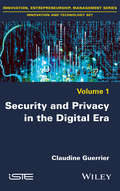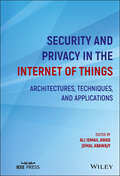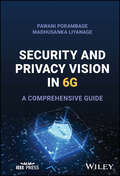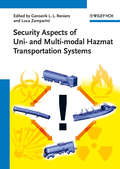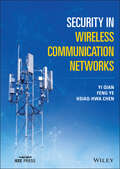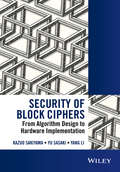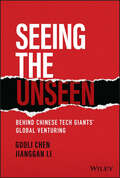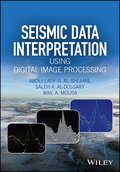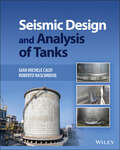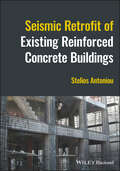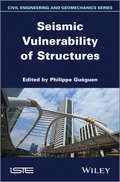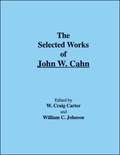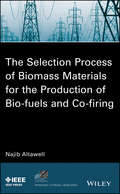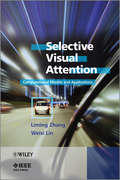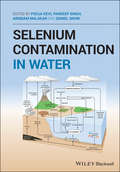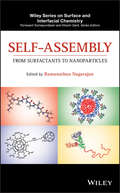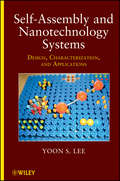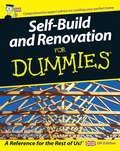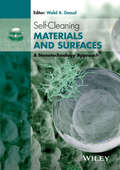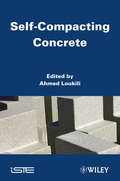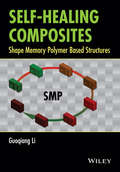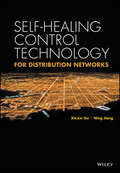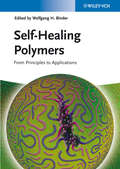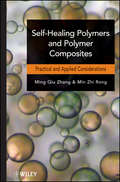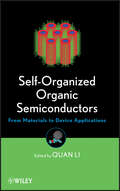- Table View
- List View
Security and Privacy in the Digital Era
by Claudine GuerrierInformation and communication technologies, particularly in the digital era, but also with the contribution of biometric applications, geolocation, video surveillance, make it possible to control civil society. The freedoms guaranteed by human rights are increasingly under threat. Is there still a balance between security and privacy? Written by a professor of law, this book offers contribution towards political science, defining the steps of a society focusing on human rights, then a society giving priority to security and security technologies.
Security and Privacy in the Internet of Things: Architectures, Techniques, and Applications
by Ali Ismail Awad Jemal AbawajySECURITY AND PRIVACY IN THE INTERNET OF THINGS Provides the authoritative and up-to-date information required for securing IoT architecture and applications The vast amount of data generated by the Internet of Things (IoT) has made information and cyber security vital for not only personal privacy, but also for the sustainability of the IoT itself. Security and Privacy in the Internet of Things brings together high-quality research on IoT security models, architectures, techniques, and application domains. This concise yet comprehensive volume explores state-of-the-art mitigations in IoT security while addressing important security and privacy challenges across different IoT layers. The book provides timely coverage of IoT architecture, security technologies and mechanisms, and applications. The authors outline emerging trends in IoT security and privacy with a focus on areas such as smart environments and e-health. Topics include authentication and access control, attack detection and prevention, securing IoT through traffic modeling, human aspects in IoT security, and IoT hardware security. Presenting the current body of knowledge in a single volume, Security and Privacy in the Internet of Things: Discusses a broad range of IoT attacks and defense mechanisms Examines IoT security and privacy protocols and approaches Covers both the logical and physical security of IoT devices Addresses IoT security through network traffic modeling Describes privacy preserving techniques in smart cities Explores current threat and vulnerability analyses Security and Privacy in the Internet of Things: Architectures, Techniques, and Applications is essential reading for researchers, industry practitioners, and students involved in IoT security development and IoT systems deployment.
Security and Privacy Vision in 6G: A Comprehensive Guide
by Pawani Porambage Madhusanka LiyanageSECURITY AND PRIVACY VISION IN 6G Prepare for the future of mobile communication with this comprehensive study 6G is the next frontier in mobile communication, with development of 6G standards slated to begin as early as 2026. As telecommunications networks become faster and more intelligent, security and privacy concerns are critical. In an increasingly connected world, there is an urgent need for user data to be safeguarded and system security enhanced against a new generation of threats. Security and Privacy Vision in 6G provides a comprehensive survey of these threats and the emerging techniques for safeguarding against them. It includes mechanisms for prediction, detection, mitigation, and prevention, such that threats to privacy and security can be forestalled at any stage. Fully engaged with proposed 6G architectures, it is an essential resource for mobile communications professionals looking for a head start on the technology of the future. Security and Privacy Vision in 6G readers will also find: Detailed coverage of topics including edge intelligence and cloudification, industrial automation, collaborative robots, and more Treatment balancing the practical and the theoretical An editorial team with decades of international network technology experience in both industry and academia Security and Privacy Vision in 6G is a vital reference for network security professionals and for postgraduate and advanced undergraduate students in mobile communications and network security-related fields.
Security Aspects of Uni- and Multimodal Hazmat Transportation Systems
by Genserik L. Reniers Luca ZampariniWritten in a clear language, for use by scholars, managers and decisionmakers, this practical guide to the hot topic is unique in treating thesecurity aspects of hazmat transportation from both uni-modal and multi-modal perspectives. To begin with, each transport mode and itsrelation to security vulnerability, analyses, figures, and approaches is discussed separately. Secondly, the optimization process of a hazmatsupply chain is examined from a holistic, integrated viewpoint. Finally, the book discusses and compares the various hazmat transport securitypolicies and strategies adopted in various regions around the world. The result is a must-have source of high-quality information includingmany case studies.
Security in Wireless Communication Networks (IEEE Press)
by Yi Qian Feng Ye Hsiao-Hwa ChenReceive comprehensive instruction on the fundamentals of wireless security from three leading international voices in the field Security in Wireless Communication Networksdelivers a thorough grounding in wireless communication security. The distinguished authors pay particular attention to wireless specific issues, like authentication protocols for various wireless communication networks,encryption algorithms and integrity schemes on radio channels, lessons learned from designing secure wireless systems and standardization for security in wireless systems. The book addresses how engineers, administrators, and others involved in the design and maintenance of wireless networks can achieve security while retaining the broadcast nature of the system, with all of its inherent harshness and interference. Readers will learn: A comprehensive introduction to the background of wireless communication network security, including a broad overview of wireless communication networks, security services, the mathematics crucial to the subject, and cryptographic techniques An exploration of wireless local area network security, including Bluetooth security, Wi-Fi security, and body area network security An examination of wide area wireless network security, including treatments of 2G, 3G, and 4G Discussions of future development in wireless security, including 5G, and vehicular ad-hoc network security Perfect for undergraduate and graduate students in programs related to wireless communication, Security in Wireless Communication Networks will also earn a place in the libraries of professors, researchers, scientists, engineers, industry managers, consultants, and members of government security agencies who seek to improve their understanding of wireless security protocols and practices.
Security of Block Ciphers: From Algorithm Design to Hardware Implementation (Wiley - IEEE)
by Kazuo Sakiyama Yu Sasaki Yang LiA comprehensive evaluation of information security analysis spanning the intersection of cryptanalysis and side-channel analysis Written by authors known within the academic cryptography community, this book presents the latest developments in current research Unique in its combination of both algorithmic-level design and hardware-level implementation; this all-round approach - algorithm to implementation – covers security from start to completion Deals with AES (Advanced Encryption standard), one of the most used symmetric-key ciphers, which helps the reader to learn the fundamental theory of cryptanalysis and practical applications of side-channel analysis
Seeing the Unseen: Behind Chinese Tech Giants' Global Venturing
by Guoli Chen Jianggan LiMeet the overnight tech success stories of China&’s globalizing business landscape In the last few years, we have seen a meteoric rise of Chinese tech companies across the world. Alibaba stock price movements unnerved investors globally, venture capitalists searched for the next Meituan or Pinduoduo in Southeast Asia and Latin America, and of course, Tik Tok, the most popular content platform in the world today, originated from China. The founders of such companies are typically credited with the &“tenacity to rough it out,&” the &“courage to venture into the unknown,&” and the &“vision to take their companies to new heights.&” However, the same can be said about Silicon Valley founders, or any successful entrepreneur. So, what gives Chinese founders and their companies the advantage in becoming multi-billion global enterprises? How does their leadership set strategies? How do they motivate their people? How do they move so fast and defend their turf in China&’s hyper-competitive tech market? When they expand overseas, how do they determine what they keep and what they need to let go of? And most importantly, what do these things mean to you as a competitor, investor, regulator, or even as an executive or customer of such companies? Seeing the Unseen: Behind Chinese Tech Giants&’ Global Venturing answers these questions and delves into the fascinating world of Chinese logic that shapes how tech leaders make and implement decisions, many of which are seldom seen outside China. In this book, you will gain an accurate, concise understanding of Chinese tech companies' reflections as they scale. You will understand the different generations of Chinese tech giants from Alibaba, Tencent, Baidu and Huawei to Pinduoduo, Meituan, ByteDance, Xiaomi and more. In this Seeing the Unseen, the analysis behind the success and lessons learned is summarized into a unique framework that touches on People, Organization, and Product and Leadership (POP-Leadership). The book covers: How Chinese history, folklore and Mao Zadong&’s political strategies have shaped the strategies of Chinese tech leaders, even today The mindsets of Chinese tech and internet companies and how they have evolved over the last two decades The unique business culture and leadership styles that steered these companies through uncertain and ultra-competitive periods How Chinese companies structure their organizations and products and how they remain agile as they scale The limitations of Chinese POP-Leadership, and what these companies must shed to keep up with international players in global markets How Chinese POP-Leadership is now becoming international, and how international players are leveraging these learnings How the worldwide expansion of Chinese companies will alter the business landscape in the coming decades Chinese firms undertaking overseas ventures can challenge our thinking on global strategy and implementation. This book gives you a better understanding of these emergent players in the global arena.
Seismic Data Interpretation using Digital Image Processing
by Abdullatif A. Al-Shuhail Saleh A. Al-Dossary Wail A. MousaBridging the gap between modern image processing practices by the scientific community at large and the world of geology and reflection seismology This book covers the basics of seismic exploration, with a focus on image processing techniques as applied to seismic data. Discussions of theories, concepts, and algorithms are followed by synthetic and real data examples to provide the reader with a practical understanding of the image processing technique and to enable the reader to apply these techniques to seismic data. The book will also help readers interested in devising new algorithms, software and hardware for interpreting seismic data. Key Features: Provides an easy to understand overview of popular seismic processing and interpretation techniques from the point of view of a digital signal processor. Presents image processing concepts that may be readily applied directly to seismic data. Includes ready-to-run MATLAB algorithms for most of the techniques presented. The book includes essential research and teaching material for digital signal and image processing individuals interested in learning seismic data interpretation from the point of view of digital signal processing. It is an ideal resource for students, professors and working professionals who are interested in learning about the application of digital signal processing theory and algorithms to seismic data.
Seismic Design and Analysis of Tanks
by Gian Michele Calvi Roberto NascimbeneSeismic Design and Analysis of Tanks A detailed view on the effects of seismic activity on tank structures As the use of above-ground and underground storage tanks (ASTs and USTs) continues to grow—with approximately 545,000 in the USA alone—the greatest threat to ASTs and USTs is earthquakes, causing the contamination of groundwater, a vital source of drinking water throughout the world. These tanks suffer a great deal of strain during an earthquake, as a complicated pattern of stress affects them, such that poorly designed tanks have leaked, buckled, or even collapsed during seismic events. Furthermore, in oil and gas industrial plants, the risk of damage is even more critical due to the effects of explosion, collapse, and air or soil contamination by chemical fluid spillages. Seismic Design and Analysis of Tanks provides the first in-depth discussion of the principles and applications of shell structure design and earthquake engineering analyses focused on tank structures, and it explains how these methodologies can help prevent the destruction of ASTs and USTs during earthquakes. Providing a thorough examination of the design, analysis, and performance of steel, reinforced concrete, and precast tanks, this book takes a look at tanks that are above-ground, underground, or elevated, anchored and unanchored, and rigid or flexible, and evaluates the efficacy of each method during times of seismic shaking—and it does so without getting bogged down in impenetrable mathematics and theory. Seismic Design and Analysis of Tanks readers will also find: A global approach to the best analytical and practical solutions available in each region: discussion of the latest US codes and standards from the American Society of Civil Engineers (ACSE 7), the American Concrete Institute (ACI 350,3, 371.R), the American Water Works Association (AWWA D100, D110, D115), and the American Petroleum Institute (API 650) an overview of the European codes and standards, including Eurocode 8-4 and CEN-EN 14015 Hundreds of step-by-step equations, accompanied by illustrations Photographs illustrating real-world damage to tanks caused by seismic events Perfect for practising structural engineers, geotechnical engineers, civil engineers, and engineers of all kinds who are responsible for the design, analysis, and performance of tanks and their foundations—as well as students studying engineering—Seismic Design and Analysis of Tanks is a landmark text, the first work of its kind to deal with the seismic engineering performance of all types of storage tanks.
Seismic Retrofit of Existing Reinforced Concrete Buildings
by Stelios AntoniouSeismic Retrofit of Existing Reinforced Concrete Buildings Understand the complexities and challenges of retrofitting building infrastructure Across the world, buildings are gradually becoming structurally unsound. Many were constructed before seismic load capacity was a mandatory component of building standards, and were often built with low-quality materials or using unsafe construction practices. Many more are simply aging, with materials degrading, and steel corroding. As a result, efforts are ongoing to retrofit existing structures, and to develop new techniques for assessing and enhancing seismic load capacity in order to create a safer building infrastructure worldwide. Seismic Retrofit of Existing Reinforced Concrete Buildings provides a thorough book-length discussion of these techniques and their applications. Balancing theory and practice, the book provides engineers with a broad base of knowledge from which to approach real-world seismic assessments and retrofitting projects. It incorporates knowledge and experience frequently omitted from the building design process for a fuller account of this critical engineering subfield. Seismic Retrofit of Existing Reinforced Concrete Buildings readers will also find: Detailed treatment of each available strengthening technique, complete with advantages and disadvantages In-depth guidelines to select a specific technique for a given building type and/or engineering scenario Step-by-step guidance through the assessment/retrofitting process Seismic Retrofit of Existing Reinforced Concrete Buildings is an ideal reference for civil and structural engineering professionals and advanced students, particularly those working in seismically active areas.
Seismic Vulnerability of Structures (Wiley-iste Ser.)
by Philippe GueguenThis book is focused on the seismic vulnerability assessment methods, applied to existing buildings, describing several behaviors and new approaches for assessment on a large scale (urban area). It is clear that the majority of urban centers are composed of old buildings, designed according to concepts and rules that are inadequate to the seismic context. How to assess the vulnerability of existing buildings is an essential step to improve the management of seismic risk and its prevention policy. After some key reminders, this book describes seismic vulnerability methods applied to a large number of structures (buildings and bridges) in moderate (France, Switzerland) and strong seismic prone regions (Italy, Greece). Contents 1. Seismic Vulnerability of Existing Buildings: Observational and Mechanical Approaches for Application in Urban Areas, Sergio Lagomarsino and Serena Cattari. 2. Mechanical Methods: Fragility Curves and Pushover Analysis, Caterina Negulescu and Pierre Gehl. 3. Seismic Vulnerability and Loss Assessment for Buildings in Greece, Andreas J. Kappos. 4. Experimental Method: Contribution of Ambient Vibration Recordings to the Vulnerability Assessment, Clotaire Michel and Philippe Guéguen. 5. Numerical Model: Simplified Strategies for Vulnerability Seismic Assessment of Existing Structures, Cédric Desprez, Panagiotis Kotronis and Stéphane Grange. 6. Approach Based on the Risk Used in Switzerland, Pierino Lestuzzi. 7. Preliminary Evaluation of the Seismic Vulnerability of Existing Bridges, Denis Davi. About the Authors Philippe Guéguen is a Senior IFSTTAR Researcher at ISTerre, Joseph Fourier University Grenoble 1, France
The Selected Works of John W. Cahn
by W. Craig Carter William C. JohnsonThis book represents a collection of 30 selected papers from the work of John W. Cahn. Dr. Cahn is Senior Fellow at the Materials Science and Engineering Laboratory of the National Institute of Standards and Technology, and is widely recognized as a founder of modern theory and thought in materials science. The range of his research included kinetics and mechanisms of metallurgical phase changes, surfaces, interfaces, defects, quasicrystals, thermodynamics, and other areas impacting the fundamental understanding of materials science.Each paper includes a 2-4 page review of the impact and historical perspective of the work. This is an important collection for students, instructors, and scientists interested in materials science.
The Selection Process of Biomass Materials for the Production of Bio-Fuels and Co-firing
by N. AltawellA functional discussion of the crop selection process for biomass energy The Selection Process of Biomass Materials for the Production of Bio-fuels and Co-firing provides a detailed examination and analysis for a number of energy crops and their use as a source for generating electricity and for the production of bio-fuels. Renowned renewable energy expert and consultant Dr. Najib Altawell begins with the fundamentals of bio-fuels and co-firing and moves on to the main feature, which is the methodology that assists energy scientists and engineers to arrive at the most suitable biomass materials tailored to each company's business and economic environments and objectives. This methodology provides a framework whereby power-generating companies can insert their own values for each factor, whether business factor (BF) or scientific & technical factors (S&T) or both simultaneously. The methodology provides a list of factors related to the biomass energy business. The average values have been obtained from the survey method and laboratory tests. These values are the standard values power companies can use if they need or wish to use them. The Selection Process of Biomass Materials for the Production of Bio-fuels and Co-firing has been designed and compiled for the widest possible range of readers, researchers, businesspeople, and economists who are connected to the renewable energy field in general, and biomass energy in particular. Because of its focus on practical data and applications, the book is also accessible for general readers who may or may not have a technical or scientific background.
Selective Visual Attention: Computational Models and Applications (Wiley - IEEE)
by Liming Zhang Weisi LinVisual attention is a relatively new area of study combining a number of disciplines: artificial neural networks, artificial intelligence, vision science and psychology. The aim is to build computational models similar to human vision in order to solve tough problems for many potential applications including object recognition, unmanned vehicle navigation, and image and video coding and processing. In this book, the authors provide an up to date and highly applied introduction to the topic of visual attention, aiding researchers in creating powerful computer vision systems. Areas covered include the significance of vision research, psychology and computer vision, existing computational visual attention models, and the authors' contributions on visual attention models, and applications in various image and video processing tasks. This book is geared for graduates students and researchers in neural networks, image processing, machine learning, computer vision, and other areas of biologically inspired model building and applications. The book can also be used by practicing engineers looking for techniques involving the application of image coding, video processing, machine vision and brain-like robots to real-world systems. Other students and researchers with interdisciplinary interests will also find this book appealing. Provides a key knowledge boost to developers of image processing applications Is unique in emphasizing the practical utility of attention mechanisms Includes a number of real-world examples that readers can implement in their own work: robot navigation and object selection image and video quality assessment image and video coding Provides codes for users to apply in practical attentional models and mechanisms
Selenium Contamination in Water
by Pooja Devi Pardeep Singh Arindam Malakar Daniel SnowThe contamination of environment and water resources by Selenium (Se) and its oxyanions from various sources are emerging contaminants of significant health and environmental concern. The primary sources include agricultural drainage water, mine drainage, residues from fossil fuels, thermoelectric power plants, oil refineries, and metal ores. Various methods and technologies have been developed which focus on the treatment of selenium-containing waters and wastewater. High concentrations of selenium in water cause various adverse impact to human health, such as carcinogenic, genotoxic, and cytotoxic effects. But in the lower concentrations, it is a useful constituent of the biological system. The range between toxicity and deficiency of selenium is minimal (40 to 400 μg per day), due to its dual nature. Selenium Contamination in Water contains the latest status and information on selenium’s origin, its chemistry and its toxicity to humans. The book represents a comprehensive and advanced reference book for students, researchers, practitioners, and policymakers in working in the field of metalloids, in particular selenium. A special emphasis is given on its geological distribution, monitoring techniques, and remedial technologies. As such, the authors critically analyze the various techniques used for the monitoring and removal of selenium from water. Featuring chapters arranged according to the major themes of the latest research, with specific case-studies from industrial experiences of selenium detection and removal, Selenium Contamination in Water will be particularly valued by researchers, practitioners, and policymakers in working in the field of metalloids including selenium.
Self-Assembly: From Surfactants to Nanoparticles (Wiley Series on Surface and Interfacial Chemistry)
by Ramanathan NagarajanAn introduction to the state-of-the-art of the diverse self-assembly systems Self-Assembly: From Surfactants to Nanoparticles provides an effective entry for new researchers into this exciting field while also giving the state of the art assessment of the diverse self-assembling systems for those already engaged in this research. Over the last twenty years, self-assembly has emerged as a distinct science/technology field, going well beyond the classical surfactant and block copolymer molecules, and encompassing much larger and complex molecular, biomolecular and nanoparticle systems. Within its ten chapters, each contributed by pioneers of the respective research topics, the book: Discusses the fundamental physical chemical principles that govern the formation and properties of self-assembled systems Describes important experimental techniques to characterize the properties of self-assembled systems, particularly the nature of molecular organization and structure at the nano, meso or micro scales. Provides the first exhaustive accounting of self-assembly derived from various kinds of biomolecules including peptides, DNA and proteins. Outlines methods of synthesis and functionalization of self-assembled nanoparticles and the further self-assembly of the nanoparticles into one, two or three dimensional materials. Explores numerous potential applications of self-assembled structures including nanomedicine applications of drug delivery, imaging, molecular diagnostics and theranostics, and design of materials to specification such as smart responsive materials and self-healing materials. Highlights the unifying as well as contrasting features of self-assembly, as we move from surfactant molecules to nanoparticles. Written for students and academic and industrial scientists and engineers, by pioneers of the research field, Self-Assembly: From Surfactants to Nanoparticles is a comprehensive resource on diverse self-assembly systems, that is simultaneously introductory as well as the state of the art.
Self-assembly and nanotechnology systems: design, characterization, and applications
by Yoon S. LeeA fundamental resource for understanding and developing effective self-assembly and nanotechnology systems Systematically integrating self-assembly, nanoassembly, and nanofabrication into one easy-to-use source, Self-Assembly and Nanotechnology Systems effectively helps students, professors, and researchers comprehend and develop applicable techniques for use in the field. Through case studies, countless examples, clear questions, and general applications, this book provides experiment-oriented techniques for designing, applying, and characterizing self-assembly and nanotechnology systems. Self-Assembly and Nanotechnology Systems includes: Techniques for identifying assembly building units Practical assembly methods to focus on when developing nanomaterials, nanostructures, nanoproperties, nanofabricated systems, and nanomechanics Algorithmic diagrams in each chapter for a general overview Schematics designed to link assembly principles with actual systems Hands-on lab activities This informative reference also analyzes the diverse origins and structures of assembly building units, segmental analysis, and selection of assembly principles, methods, characterization techniques, and predictive models. Complementing the author's previous conceptually based book on this topic, Self-Assembly and Nanotechnology Systems is a practical guide that grants practitioners not only the skills to properly analyze assembly building units but also how to work with applications to exercise and develop their knowledge of this rapidly advancing scientific field.
Self Build and Renovation For Dummies
by Nicholas WallimanCreating your dream home is an exciting idea, but it's also a major project and one where you need to be an expert on everything from planning laws to landscape design, and all that's in between. Self Build and Renovation For Dummies takes you through every step of the process, from choosing and buying a plot of land, through to the building's design and on to the actual build – plus all the financial and legal stuff – using plain English in an easy-to-understand format. Here is everything you need to know to create your perfect home.
Self-Cleaning Materials and Surfaces
by Dr Walid A. DaoudWith increasing demand for hygienic, self-disinfecting and contamination free surfaces, interest in developing self-cleaning protective materials and surfaces has grown rapidly in recent times. This new title comprises of invited chapters from renowned researchers in the area of self-cleaning nano-coatings and the result is a comprehensive review of current research on both hydrophobic and hydrophilic (photocatalytic effect) self-cleaning materials.
Self-Compacting Concrete (Wiley-iste Ser. #558)
by Ahmed LoukiliSelf-Compacting Concrete (SCC) is a relatively new building material. Nowadays, its use is progressively changing the method of concrete placement on building sites. However, the successful use of SCC requires a good understanding of the behavior of this material, which is vastly different from traditional concrete. For this purpose, a lot of research has been conducted on this area all over the world since 10 years. Intended for both practitioners and scientists, this book provides research results from the rheological behavior of fresh concrete to durability.
Self-Healing Composites: Shape Memory Polymer Based Structures
by Guoqiang LiIn this book, the self-healing of composite structures with shape memory polymer as either matrix or embedded suture is systematically discussed. Self-healing has been well known in biological systems for many years: a typical example is the self-healing of human skin. Whilst a minor wound can be self-closed by blood clotting, a deep and wide cut needs external help by suturing. Inspired by this observation, this book proposes a two-step close-then-heal (CTH) scheme for healing wide-opened cracks in composite structures–by constrained shape recovery first, followed by molecular healing. It is demonstrated that the CTH scheme can heal wide-opened structural cracks repeatedly, efficiently, timely, and molecularly. It is believed that self-healing represents the next-generation technology and will become an engineering reality in the near future. The book consists of both fundamental background and practical skills for implementing the CTH scheme, with additional focus on understanding strain memory versus stress memory and healing efficiency evaluation under various fracture modes. Potential applications to civil engineering structures, including sealant for bridge decks and concrete pavements, and rutting resistant asphalt pavements, are also explored. This book will help readers to understand this emerging field, and to establish a framework for new innovation in this direction. Key features: explores potential applications of shape memory polymers in civil engineering structures, which is believed to be unique within the literature balanced testing and mathematical modeling, useful for both academic researchers and practitioners the self-healing scheme is based on physical change of polymers and is written in an easy to understand style for engineering professionals without a strong background in chemistry
Self-healing Control Technology for Distribution Networks
by Xinxin Gu Ning Jiang China Electric Power PressSystematically introduces self-healing control theory for distribution networks, rigorously supported by simulations and applications• A comprehensive introduction to self-healing control for distribution networks• Details the construction of self-healing control systems with simulations and applications• Provides key principles for new generation protective relay and network protection• Demonstrates how to monitor and manage system performance• Highlights practical implementation of self-healing control technologies, backed by rigorous research data and simulations
Self-Healing Polymers
by Wolfgang H. BinderThis self-contained reference, written by a team of renowned international authors adopt a didactical approach to systematically cover all important aspects of designing self-healing polymers from concepts to applications - transferring lessons learnt from nature to materials science. It is the first to discuss the chemical and physical concepts for self-healing polymers, including aspects of biomimetic processes of healing in nature and tissue regeneration. Chapters cover the design of self-healing polymers and explain the dynamics in these systems.Different self-healing concepts such as encapsulated systems and supramolecular systems are also included, with analysis and friction detection in self-healing polymers and on applications rounding off the whole.
Self-Healing Polymers and Polymer Composites
by Ming Qiu Zhang Min Zhi RongA state-of-art guide on the interdisciplinary aspects of design, chemistry, and physical properties of bio-inspired self-healing polymers Inspired by the natural self-healing properties that exist in living organisms-for example, the regenerative ability of humans to heal from cuts and broken bones-interest in self-healing materials is gaining more and more attention. Addressing the broad advances being made in this emerging science, Self-Healing Polymers and Polymer Composites incorporates fundamentals, theory, design, fabrication, characterization, and application of self-healing polymers and polymer composites to describe how to prepare self-healing polymeric materials, how to increase the speed of crack repair below room temperature, and how to broaden the spectrum of healing agent species. Some of the information readers will discover in this book include: Focus on engineering aspects and theoretical backgrounds of smart materials The systematic route for developing techniques and materials to advance the research and applications of self-healing polymers Integration of existing techniques and introduction of novel synthetic approaches and target-oriented materials design and fabrication Techniques for characterizing the healing process of polymers and applications of self-healing polymers and polymer composites Practical aspects of self-healing technology in various industrial fields, such as electronics, automotive, construction, chemical production, and engineering With this book, readers will have a comprehensive understanding of this emerging field, while new researchers will understand the framework necessary for innovating new self-healing solutions.
Self-Organized Organic Semiconductors
by Quan LiThis book focuses on the exciting topic on self-organized organic semiconductors - from materials to device applications. It offers up-to-date and accessible coverage of self-organized semiconductors for organic chemistry, polymer science, liquid crystals, materials science, material engineering, electrical engineering, chemical engineering, optics, optic-electronics, nanotechnology and semiconductors. Chapters cover chemistry, physics, processing, and characterization. The applications include photovoltaics, light-emitting diodes (LEDs), and transistors.
